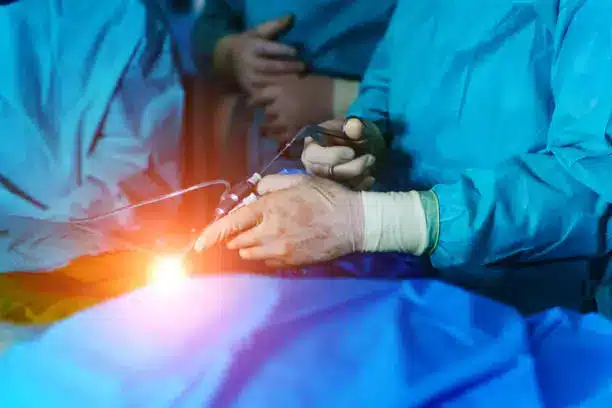1120 NW 14th Street / Miami, FL 33136

Laminectomy Surgery: Recovery Time & Treatment Cost
When the lamina is removed, it helps relieve nerve compression and results in reduced pain and weakness. For those patients, conservative methods, such as medications or injections, have not provided effective relief; laminectomy is a widely performed treatment.Different conditions for which laminectomy is performed:
Spinal stenosis
Spinal stenosis is a condition where the narrowing of the spinal canal occurs. This narrowing of the spinal canal can lead to compression of the spinal cord and nerve roots. When the narrowing occurs, it can cause pain and nerve-related issues. The main causes of spinal stenosis can be aging and injuries. Laminectomy is performed for the treatment of spinal stenosis with the removal of the lamina, which offers space for the nerves and spinal cord.Herniated discs
A herniated disc can occur when the soft center of the spinal disc pushes out, which can cause pain and weakness. Age-related degeneration and injury can be the causes of a herniated disc. This condition can be resolved with conservative treatment, but in some cases, when the symptoms worsen, laminectomy can be a good surgical option for the treatment of this condition.Degenerative disc disease
Degenerative disc disease can be caused by aging, in which the intervertebral discs in the spine lose their elasticity. The other cause of degenerative disc disease can be injury, which can lead to pain. The most common areas where this condition occurs are the cervical and lumbar regions.Spinal tumors
The spinal tumor is an abnormal growth of tissue around or in the spinal cord or vertebral column. This condition can be treated by the surgical procedure, laminectomy.Spondylolisthesis
The condition is where one vertebra in the spine slips over another. This condition leads to misalignment of the vertebrae, which causes lower back pain. A fracture, degeneration, and birth defect can be the causes of spondylolisthesis. This condition can be treated with a laminectomy surgery.What are the types of Laminectomy performed?
Different types of laminectomy can be performed for the treatment of different conditions, such as:Lumbar Laminectomy
Lumbar Laminectomy is a surgical procedure performed to relieve the pressure on the spinal cord and nerves in the lower back. In this procedure, a portion of the vertebral bone is removed from the lower spine. This procedure allows the nerves and spinal cord to function properly.Cervical Laminectomy
This surgical procedure is performed to relieve the pressure on the spinal cord and nerves in the neck with the removal of the bony arch (lamina) of the vertebrae. The purpose of this procedure is to widen the spinal canal.Thoracic Laminectomy
A thoracic laminectomy is a surgical procedure that is performed to offer relief from the pressure on the spinal cord or nerve in the mid-back region. This procedure involves the removal of the vertebral lamina. The surgery is performed to address different conditions, such as spinal stenosis and tumors. Laminectomy surgery is a treatment performed under general anesthesia, and the time taken for the procedure can be 1-3 hours.What is the recovery time after laminectomy?
The recovery time after the surgical procedure, laminectomy, can vary depending on several factors, such as the complexity of the procedure performed, overall health, and age. Most of the patients have experienced faster recovery with reduced pain and discomfort. Here is a detail about the recovery period after the laminectomy.Post-operative period
- Patients are monitored for pain and complications just after the surgical procedure.
- If a patient experiences pain, then pain is managed with medications.
- In this period, the patient is encouraged to sit or walk with assistance.
The first week after the surgery
- Most of the patients return home within 1-3 days after the surgery.
- A patient can walk a little, but the activities are limited.
- Pain can be managed at home.
The first Month after the surgery
- Now the patient can experience the gradual improvement and reduced pain.
- In this period, light physical therapy can be recommended.
- It is suggested to avoid lifting heavy objects.
6 Weeks to 3 Months
- Mostly, patients return to their daily activities in this recovery period.
- There is a continuous improvement in the nerve function.
- A little hard physical therapy can be started.
What are the potential risks and complications?
Laminectomy is generally considered a safe procedure for the treatment of different conditions. But still, it is a surgical procedure, and it can have some risks, whether small or larger ones. Here are some potential risks and considerations of laminectomy surgery:- Infection
- Blood clots
- Nerve damage
- Spinal fluid leak
- Continued or recurrent symptoms
- Need for additional. surgery
Treatment Cost of Laminectomy Surgery
The treatment cost of the laminectomy surgery in Miami can depend on different factors, such as the complexity of the case, the type of hospital, surgeon, insurance coverage, and location. Here is an estimated treatment cost of the Laminectomy surgery.| Procedure | Estimated Cost |
| Laminectomy surgery | $35,000 - $70,000+ |
| Pre-operative test | $500 - $2,000 |
| Post-operative care | $1,000 - $5,000 |
| Hospital stays | $5,000 - $15,000 |
| Anesthesia | $2,000 - $5,000 |
| Surgeon fees | $5,000 - $20,000+ |

